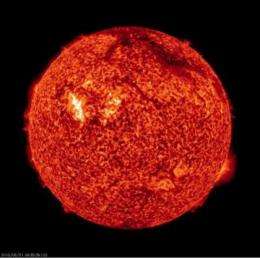Radio observatory helps identify missing link between solar storms and radio bursts

(Phys.org) —New research by scientists at Trinity College Dublin, University College London, and the University of Hawai'i, published online in Nature Physics, has shown for the first time a direct link between solar storms, shock waves and solar radio bursts.
The Sun gives light and heat that makes life possible on Earth. It can, however, have more sinister effects, sometimes unleashing huge eruptions of hot gas, called solar storms, which carry billions of tons of matter travelling at millions of kilometres an hour in Earth's direction. These storms can be accompanied by solar radio bursts, which can cause damaging effects on many of the technologies that we rely on in our everyday lives.
"Radio bursts from solar storms can have adverse effects on both satellite and terrestrial communications. In fact, mobile phone networks can experience increased dropped-calls during periods of increased solar activity," said Eoin Carley, Irish Research Council PhD student at the School of Physics, Trinity College Dublin and first author on a recent paper on this topic in Nature Physics.
Despite decades of study, the link between solar storms and solar radio bursts has remained unclear. This led Professor Peter Gallagher, a solar physicist at Trinity's School of Physics, to establish a radio observatory at Birr Castle in the midlands of Ireland to monitor solar radio bursts.
"What we have found is fascinating – a real insight into how solar radio bursts are created", said Professor Gallagher. "Using antennas at Trinity's Rosse Observatory in Birr Castle together with images from NASA's STEREO and Solar Dynamics Observatory spacecraft, we have identified a missing link between solar storms and radio bursts."
The findings, which were published online this week in Nature Physics, show that solar storms create huge shock waves that race through the solar atmosphere at millions of kilometres per hours. As they do, they can accelerate electrons to huge energies, which then produce radio waves.
"Our results not only give an insight into the fundamental physics of explosions on the Sun, but enable us to better understand how the Sun affects the Earth and potentially its impacts on our daily lives" according to Carley.
More information: www.nature.com/nphys/journal/v … /full/nphys2787.html
Journal information: Nature Physics
Provided by Trinity College Dublin




















